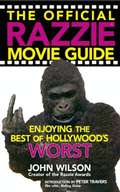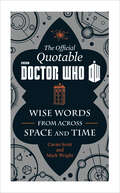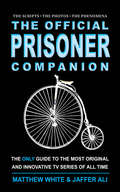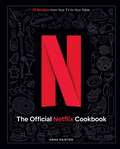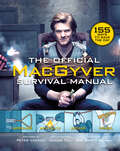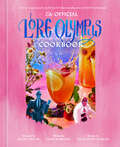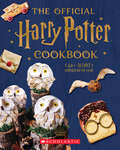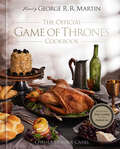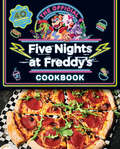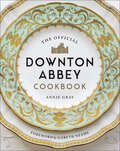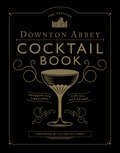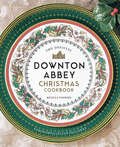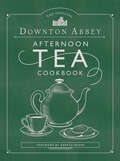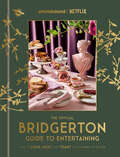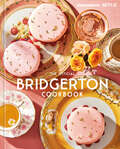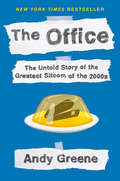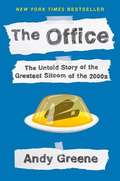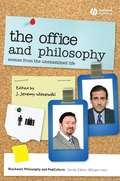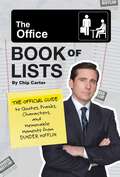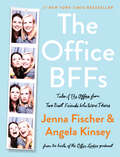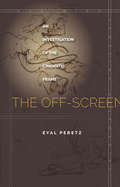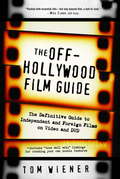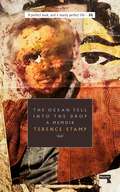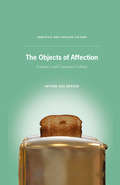- Table View
- List View
The Official Razzie Movie Guide: Enjoying the Best of Hollywood's Worst
by John WilsonA paperback guide to 100 of the funniest bad movies ever made, this book covers a wide range of hopeless Hollywood product, and also including rare Razzie ceremony photos and a complete history of everything ever nominated for Tinsel Town's Tackiest Trophy.
The Official Quotable Doctor Who: Wise Words From Across Space and Time
by Cavan Scott Mark Wright"All of time and space. All things that ever happened or ever will. Where do you want to start?"From a junkyard in Totter's Lane to the fields of Trenzalore, the last of the Time Lords has navigated the past, present, and future using knowledge gathered from centuries of adventures in space and time. Now the authors of the bestselling Who-Ology have collected the best of that timey-wimey knowledge into one place. Covering themes of home and work, travel and technology, the history of the Earth and the fate of the future—you'll find a Doctor-y bon mot for every occasion here.Collecting half a century of quips and quotes, and beautifully illustrated throughout, The Official Quotable Doctor Who is your indispensable guide to life, love, mirth, and monsters.
The Official Prisoner Companion
by Matthew White Jaffer AliIt is called, with deceptive simplicity. The Village. It is the world of tomorrow, or today. A man known only as Number 6 enters its storybook-like confines. He will learn, over and over again, that inside it there is no freedom, and from it there is no escape. He is without defenses, except for one invisible weapon: his uncrushable spirit.
The Official Netflix Cookbook: 70 Recipes from Your TV to Your Table
by Anna PainterEnjoy 70 delicious dishes inspired by iconic Netflix movies and series with Netflix: The Official Cookbook!You&’re settling in for a night of watching the next volume of your favorite show and you&’re going to need snacks! Netflix: The Official Cookbook offers Netflix-inspired food and drinks to create the best menu to devour along with the latest season of your favorite show. Pair your Netflix home menu of shows, movies, docuseries, and stand-up comedy specials with the perfect snacks, main courses, desserts, and drinks. Each chapter offers delicious Netflix-category themed cuisine that will give viewers the perfect additions to their Casual Viewing, Familiar Favorites, and Watch In One Night marathons! Prepare a themed meal to enhance your 90-Minute Movie viewing experience or make delicious desserts based on TV Shows Based on Books. Prepare to Watch It Again and cook it again! 70 RECIPES INSPIRED BY NETFLIX: Netflix: The Official Cookbook serves up appetizers, meals, and desserts inspired by Netflix&’s series and popular categories to create the perfect snacking and streaming experience FOOD FOR EVERY GENRE: Netflix: The Official Cookbook references the popular shows and tailored-for-you categories that fans of the streaming service know and love. Offering new recipes inspired by your favorite Netflix categories, you will be treated to an immersive experience RECIPES FOR ALL SKILL LEVELS: With accessible step-by-step instructions and helpful cooking tips for everyone, Netflix: The Official Cookbook is a great guide for fans of any skill level, from kitchen novices to seasoned chefs TOP PICKS FOR GIFTS: With 70 recipes, Netflix: The Official Cookbook is the perfect gift for the serious streamer in your life ONLY ON NETFLIX: The only cookbook with official recipes directly inspired by the Netflix viewing experience
The Official MacGyver Survival Manual: 155 Ways to Save the Day
by Allain RhettHandy (and often hilarious) hacks from the resourceful TV hero. Includes illustrations! For over thirty years, the name MacGyver has been synonymous with astonishing feats of ingenuity, from fixing a car with nothing but water and egg whites to busting out of jail using a hairpin and a pair of repurposed handcuffs to, of course, saving the world with his favorite weapon, a simple paperclip. What you might not know is that every trick that the resourceful secret agent pulls off on CBS&’s hit show has been tested and fact-checked by experts, and really works . . . most of the time. No one is saying that you should craft a DIY airplane out of trash bags and a lawnmower engine. But with this book, you could. The first official how-to guide to the MacGyver universe, this book is packed with drawings and step-by-step descriptions of the hacks that made this character the world&’s most resourceful secret agent. It&’s lots of fun for fans of the new hit series as well as the classic show that started it all—or anyone who enjoys a bit of applied physics and clever problem-solving.
The Official Lore Olympus Cookbook (Lore Olympus)
by Genn McMenemy Rachel Smythe Diana MoutsopoulosFeast like the gods with sixty food and drink recipes inspired by the world of Lore Olympus—with a foreword by Rachel Smythe, plus sumptuous illustrations and photographs throughout!Uncover the culinary secrets of the Lore Olympus pantheon with this official cookbook that breathes fresh life into traditional Greek cuisine. Organized by season, each chapter offers a recipe for any time of day—whether you are hankering for breakfast, lunch, dinner, or a bright pink mocktail! And if you want to party like an Olympian, there are four feasts at the end of each section to serve as inspiration for a themed party.In these delectable recipes:Discover the divinity of Persephone&’s baklavaWork your own magic with a color-changing cocktail favored by HecateSavor mouthwatering souvlaki (with easy instructions for cooking in the oven if, like a certain King of the Underworld, you don&’t have an outdoor grill)And more!The Official Lore Olympus Cookbook is a must-have for all fans of the Eisner Award–winning series.
The Official Harry Potter Cookbook: 40+ Recipes Inspired by the Films
by Joanna FarrowCreate delicious recipes inspired by the Wizarding World in The Official Harry Potter Cookbook -- the companion to the #1 New York Times bestseller The Official Harry Potter Baking Book ! Cook your way through Hogwarts and the rest of the Wizarding World in this official cookbook inspired by the Harry Potter films! This gorgeous book is packed with full-color photography and over 40 recipes -- both savory and sweet -- including snacks, desserts, drinks, and meals fit for a Hogwarts feast!Whip up some Owl Post savory crepes, Hagrid’s hearty soup, Draco Malfoy blondies, Sir Cadogan’s sword kebabs, a troll bogey smoothie, and more! Nutritional and dietary information is provided throughout, along with gluten-free, vegetarian, and vegan options. Plus, this cookbook features tons of cooking tips and advice for the youngest aspiring chefs, including recipes with step-by-step instructions that are easy for kids to follow. The perfect book for any beginning cook and Harry Potter fan!
The Official Game of Thrones Cookbook: Recipes from King's Landing to the Dothraki Sea
by Chelsea Monroe-CasselFrom the world of George R. R. Martin&’s A Song of Ice and Fire comes a collection of 80 delicious recipes inspired by the histories of Westeros, Essos, and beyond.For those who long to dine with the Dragonlords of Old Valyria or quaff a cup of mead with King Robert I, The Official Game of Thrones Cookbook unlocks the vast culinary world of George R. R. Martin&’s A Song of Ice and Fire. Presented as the in-world manuscript of a Citadel maester, these eighty recipes take the reader on a delectable journey throughout the Seven Kingdoms, across the Narrow Sea, and back into the annals of history.The book is created by Chelsea Monroe-Cassel, who tends the popular &“Inn at the Crossroads&” food blog and co-authored A Feast of Ice and Fire. Her Maester Alton is curious, food-obsessed, and loves the fare of the highborn and small folk alike. His recipes evoke the world&’s regions, history, and stories in a charming and knowledgeable voice.The eight chapters offer recipes for every meal of the day, including Dothraki Blood Pie, Crown Roast of Boar&’s Ribs, Dornish Creamcakes, Redwyne Roasted Grapes, Seaweed Ship&’s Biscuits, Barley Griddle Cakes, Winter Town Wassail. Recipes are illustrated by mouthwatering food photography and stunning woodcut illustrations. A resource section suggests menus by region, so you can hold a feast in Riverlands, The Wall, or Braavos. Complete with an introduction by George R. R. Martin, The Official Game of Thrones Cookbook transports you to a much-loved world where trestle tables groan with sumptuous feasts, goblets overflow with mead, and winter is always coming.
The Official Five Nights at Freddy's Cookbook (Five Nights at Freddy's)
by Scott Cawthon Rob MorrisThe one and only OFFICIAL Five Nights at Freddy's Cookbook, an AFK book, with over 40 recipes inspired by the hit games. Delight in over forty tasty recipes inspired by the Five Nights at Freddy's games, with gorgeous, eye-popping photography! From Freddy Fazbear's Pepperoni X-Press and Chica's Ultimate Thai Chicken Burger, to Foxy's Fruity Cove Coolor and El Chip's Fully Loaded Tortillas, the official Five Nights at Freddy's Cookbook is packed with mouthwatering recipes that are hauntingly delicious. <P><P><i>Advisory: Bookshare has learned that this book offers only partial accessibility. We have kept it in the collection because it is useful for some of our members. Benetech is actively working on projects to improve accessibility issues such as these.</i> <p> <b>New York Times Bestseller</b>
The Official Emily in Paris Cocktail Book: Glamorous Mixed Drinks for Any Time of Day
by Weldon OwenSip your way through Paris with 50+ recipes for drinks, from classic cocktails to contemporary non-alcoholic refreshers. Enjoy a taste of Emily&’s glamorous life with favorites such as the Sancerre Breakfast Wine Cocktail and the Champagne Spray. Stir up classic French staples such as the French 75 and the Boulevardier, or imbibe with new nonalcoholic twists on old favorites. Featuring lavish photos from the show, fan-favorite quotes; and tips for throwing cocktail fêtes, viewing parties, and drinking games, fans of Emily in Paris, Francophiles, and home bartenders alike can celebrate the hit series and French culture with this must-have cocktail book. 50+ RECIPES INSPIRED BY EMILY IN PARIS: With a broad selection of French classics, elegant wine cocktails, fan-inspired drinks, and more, The Official Emily in Paris Cocktail Book celebrates classic and contemporary libations inspired by the Netflix series RECIPES FOR EVERY OCCASION: Whether you&’re shaking up nonalcoholic sippers perfect for the beaches of Southern France, stirring together a batch of punch for a watch party, or pouring pitchers of brunch margs for the gals, The Official Emily in Paris Cocktail Book is a priceless guide to entertaining and imbibing for every occasion NOT JUST COCKTAILS: Includes tasty mocktail recipes as well. THE FIRST OFFICIAL EMILY IN PARIS COCKTAIL GUIDE: The only cocktail volume with recipes officially from the set of Emily in Paris. The perfect gift for the Emily in Paris fan in your life INSPIRING IMAGES: Filled with beautiful full-color photography of the drinks to help ensure success.
The Official Downton Abbey Cookbook (Downton Abbey Cookery)
by Annie GrayRecipes, notes, and photos from the show, &“sumptuously presented in spectacular fashion even the blessed Lady Mary would approve of&” (Chowhound). Food historian and show consultant Annie Gray gives a rich and fascinating insight into the background of the dishes that were popular between 1912 and 1926, when Downton Abbey is set—a period of tremendous change and conflict, as well as culinary development. With a foreword by executive producer and co-creator Gareth Neame, and featuring over one hundred stunning color photographs, The Official Downton Abbey Cookbook also includes a special section on hosting Downton-themed dinner parties and presents stills from the TV series and film. Notes on the etiquette and customs of the times, quotes from the characters, and descriptions of the scenes in which the foods appear provide vivid context for the dishes. The recipes are grouped by occasion, which include breakfast; luncheons and suppers; afternoon tea and garden parties; picnics, shoots and race meets; festivities; upstairs dinner; downstairs dinner; downstairs supper and tea; and the still room. Whether adapted from original recipes of the period, replicated as seen or alluded to on screen, or typical of the time, all the recipes reflect the influences found on the Downton Abbey tables. &“A truly useful work of culinary history.&” —Publishers Weekly &“Will let you live your best Dowager Countess life.&” —Food & Wine
The Official Downton Abbey Cocktail Book: Appropriate Libations for All Occasions (Downton Abbey Cookery)
by Downton AbbeyRaise a glass to the elegant past with this collection of drinks recipes inspired by the beloved historical drama. Cocktails were introduced in the drawing rooms of Downton Abbey in the 1920s, when US prohibition inspired the popularity of American-style bars and bartenders in Britain. This well-curated selection of recipes is organized by the rooms in the Abbey in which the drinks were served, and spans everyday sips to party drinks plus hangover helpers and more. In addition to classic concoctions like a Mint Julep, Prince of Wales Punch, and Ginger Beer, this collection features character-specific variations such as Downton Heir, Turkish Attaché, The Valet, and The Chauffeur. The recipes reflect drinks concocted and served upstairs and down, as well as libations from village fairs, cocktail parties, and restaurant menus typical of the time. The book also includes tips, historical trivia, and over forty color photographs featuring cocktails and cast members.
The Official Downton Abbey Christmas Cookbook (Downton Abbey Cookery)
by Regula Ysewijn&“You don&’t have to be an English aristocrat to enjoy Yorkshire Pudding . . . or the other indulgent dishes in The Official Downton Abbey Christmas Cookbook.&” —San Jose Mercury News Take a seat at the Christmas table at Downton Abbey, the historic British estate at the heart of the popular PBS series. Downton fans will appreciate this enticing collection of more than sixty classic British holiday recipes from the Edwardian era, evocative narratives about Christmas traditions, and seasonal anecdotes from the award-winning series. Colorful photographs of finished dishes, fan-favorite moments from the Christmas episodes, and excerpts of character quotes bring the spirit of the holidays to life. Discover feast-worthy dishes from roast beef to figgy pudding and create a classic Christmas celebration with all the warmth and elegance of Downton.
The Official Downton Abbey Afternoon Tea Cookbook: Teatime Drinks, Scones, Savories And Sweets (Downton Abbey Cookery)
by Downton AbbeyA guide to this treasured English tradition with recipes, serving and decorum tips, and culinary history—as well as delightful photos from the series. Afternoon tea is a revered English tradition—and no one knows better how to prepare and enjoy a proper tea than the residents of Downton Abbey. With this alluring and vibrant cookbook, fans of the PBS series and anglophiles alike can stage every stylish element of this cultural staple of British society at home. Spanning sweet and savory classics—like Battenberg Cake, Bakewell Tart, toffee puddings, cream scones, and tea sandwiches—the recipes capture the quintessential delicacies of the time, and the proper way to serve them. This charming cookbook also features a detailed narrative history and extols the proper decorum for teatime service, from tea gowns and tearooms to preparing and serving tea. Gorgeous food photographs, lifestyle stills from the television series and recent movie, and quotes bring the characters of Downton Abbey—and this rich tradition—to life in contemporary times.
The Official Bridgerton Guide to Entertaining: How to Cook, Host, and Toast Like a Member of the Ton: A Cookbook
by Emily TimberlakeEntertain like a queen with these forty recipes for Bridgerton-style food and drink in the first official cookbook from this hugely popular Shondaland series on Netflix. Whether it&’s a sumptuous lawn party, a high tea, or a boozy late-night salon, this gorgeous cookbook delivers recipes for finger food, cocktails, and entertaining ideas that help you recreate the high society of Bridgerton in your own home. Host the perfect pique-nique, complete with the Duke&’s favorite Gooseberry Hand Pies and a rousing game of Pall Mall (played the Bridgerton way, of course). Create grazing boards with recipes like Roasted Pork Belly Skewers and Beet-Dyed Deviled Eggs that are perfect for a stylish watching party. Evoke the delightful decadence of Lady Danbury&’s Den of Iniquity with Sausage-Stuffed Mushroom Caps, an espresso martini, and an old-fashioned game of chance. These forty recipes have been developed with a modern audience in mind, offering mocktail, vegetarian, and gluten-free options to ensure that no fan is left hungry. They are presented alongside mouth-watering food photography, stills from the show, and sidebars explaining essential expertise, such as how to address a Marquis, execute the perfect curtsy, or build a macaron tower sturdy enough to last the night. It&’s time to entertain, Bridgerton-style.
The Official Bridgerton Cookbook
by Regula YsewijnTake a seat at the most sumptuous tables of the ton with over seventy recipes from the world of Bridgerton, the hugely popular Shondaland series on Netflix.The Official Bridgerton Cookbook allows you to prepare a feast worthy of Queen Charlotte herself, with dishes like Lady Featherington&’s towering Salmagundi salad, stacked high with persimmon and watercress, or Colin Bridgerton&’s Aegean Fasolada. For an intimate tête-à-tête, share a glass of mixed-citrus Vin d&’Orangerie and browned-butter Artichokes for Two. If you long for something sweet, try Queen Charlotte&’s Pink Perfection, an oversized macaron finished with fresh raspberries and edible gold, with a side of That Ice Cream, a no-churn, bourbon-cherry treat fit for the Duke of Hastings.Packed with quotes from favorite characters, show images, and fabulously photographed recipes, this gorgeous book invites fans to the Regency banquet table that is Bridgerton, with food and drink that entertains and delights.
The Office: The Untold Story of the Greatest Sitcom of the 2000s: An Oral History
by Andy GreeneThe untold stories behind The Office, one of the most iconic television shows of the twenty-first century, told by its creators, writers, and actors When did you last hang out with Jim, Pam, Dwight, Michael, and the rest of Dunder Mifflin? It might have been back in 2013, when the series finale aired . . . or it might have been last night, when you watched three episodes in a row. But either way, fifteen years after the show first aired, it&’s more popular than ever, and fans have only one problem--what to watch, or read, next. Fortunately, Rolling Stone writer Andy Greene has that answer. In his brand-new oral history, The Office: The Untold Story of the Greatest Sitcom of the 2000s, Greene will take readers behind the scenes of their favorite moments and characters. Greene gives us the true inside story behind the entire show, from its origins on the BBC through its impressive nine-season run in America, with in-depth research and exclusive interviews. Fans will get the inside scoop on key episodes from "The Dundies" to "Threat Level Midnight" and "Goodbye, Michael," including behind-the-scenes details like the battle to keep it on the air when NBC wanted to pull the plug after just six episodes and the failed attempt to bring in James Gandolfini as the new boss after Steve Carell left, spotlighting the incredible, genre-redefining show created by the family-like team, who together took a quirky British import with dicey prospects and turned it into a primetime giant with true historical and cultural significance. Hilarious, heartwarming, and revelatory, The Office gives fans and pop culture buffs a front-row seat to the phenomenal sequence of events that launched The Office into wild popularity, changing the face of television and how we all see our office lives for decades to come.
The Office: The Untold Story Of The Greatest Sitcom Of The 2000s
by Andy GreeneWhen did you last hang out with Jim, Pam, Dwight, Michael, and the rest of Dunder Mifflin? It might have been back in 2013, when the series finale aired . . . or it might have been last night, when you watched three episodes in a row. But either way, fifteen years after the show first aired, it's more popular than ever, and fans have only one problem--what to watch, or read, next. <P><P> Fortunately, Rolling Stone writer Andy Greene has that answer. In his brand-new oral history, The Office: The Untold Story of the Greatest Sitcom of the 2000s, Greene will take readers behind the scenes of their favorite moments and characters. Greene gives us the true inside story behind the entire show, from its origins on the BBC through its impressive nine-season run in America, with in-depth research and exclusive interviews. <P><P>Fans will get the inside scoop on key episodes from "The Dundies" to "Threat Level Midnight" and "Goodbye, Michael," including behind-the-scenes details like the battle to keep it on the air when NBC wanted to pull the plug after just six episodes and the failed attempt to bring in James Gandolfini as the new boss after Steve Carell left, spotlighting the incredible, genre-redefining show created by the family-like team, who together took a quirky British import with dicey prospects and turned it into a primetime giant with true historical and cultural significance. <P><P> Hilarious, heartwarming, and revelatory, The Office gives fans and pop culture buffs a front-row seat to the phenomenal sequence of events that launched The Office into wild popularity, changing the face of television and how we all see our office lives for decades to come.
The Office and Philosophy: Scenes from the Unexamined Life
by J. Jeremy WisnewskiNot many books refer to Hooters restaurant and philosopher John Stuart Mill on the same page. Focusing on the American/British television comedy series "The Office", Wisnewski (Hartwick College, Oneonta, NY) and fellow philosophers draw lessons from the quirky analysis of the unexamined life portrayed in its episodes. For example, one chapter is entitled: "Pam and Jim on the Make: The Epistemology of Self-Deception".
The Office Book of Lists: The Official Guide to Quotes, Pranks, Characters, and Memorable Moments from Dunder Mifflin
by Chip CarterPacked with compelling facts and trivia from all nine seasons, The Office Book of Lists breaks down the memorable series in a collection of 100+ easy-to-digest lists focusing on themes and characters in an irresistible package.Each entry in this comprehensive book celebrates another corner of The Office universe and offers new discoveries and facts concerning cherished characters and themes. From the most hilarious pranks played at Dunder Mifflin to Michael&’s best "That's What She Said" moments, each list will delight fans and remind them why The Office is one of the most popular comedy series of all time. Each list also helpfully indicates season and episode. Lists include: Michael&’s Inappropriate BehaviorSchrute Family History, Customs, and RitualsJim&’s PranksAngela&’s MoralsCreed ThoughtsAndy&’s Musical MomentsOffice RomancesChristmas Secret Santa GiftsField TripsKelly&’s CrushesAnd more!Including full-color photos and visuals throughout, The Office Book of Lists is an officially licensed must-have collector's item for the ultimate fan.The Office is a trademark and copyright of Universal Content Productions LLC. Licensed by Universal Studios 2020. All Rights Reserved.
The Office BFFs: Tales of "The Office" From Two Best Friends Who Were There
by Jenna Fischer Angela KinseyAn intimate, behind-the-scenes, richly illustrated celebration of beloved The Office co-stars Jenna Fischer and Angela Kinsey’s friendship, and an insiders' view of Pam Beesly, Angela Martin, and the iconic TV show. Featuring many of their never-before-seen photos. <p><p>Receptionist Pam Beesly and accountant Angela Martin had very little in common when they toiled together at Scranton’s Dunder Mifflin Paper Company. But, in reality, the two bonded in their very first days on set and, over the nine seasons of the series’ run, built a friendship that transcended the show and continues to this day. <p><p>Sharing everything from what it was like in the early days as the show struggled to gain traction, to walking their first red carpet—plus exclusive stories on the making of milestone episodes and how their lives changed when they became moms—The Office BFFs is full of the same warm and friendly tone Jenna and Angela have brought to their Office Ladies podcast. <p> <b>New York Times Bestseller</b>
The Off-Screen: An Investigation of the Cinematic Frame
by Eyal PeretzFrom the Renaissance on, a new concept of the frame becomes crucial to a range of artistic media, which in turn are organized around and fascinated by this frame. The frame decontextualizes, cutting everything that is within it from the continuity of the world and creating a realm we understand as the realm of fiction. The modern theatrical stage, framed paintings, the novel, the cinematic screen—all present us with such framed-off zones. Naturally, the frame creates a separation between inside and out. But, as this book argues, what is outside the frame, what is offstage, or off screen, remains particularly mysterious. It constitutes the primary enigma of the work of art in the modern age. It is to the historical and conceptual significance of this "off" that this book is dedicated. By focusing on what is outside the frame of a work of art, it offers a comprehensive theory of film, a concise history of American cinema from D.W. Griffith to Quentin Tarantino, and a reflection on the place and significance of film within the arts of modernity in general.
The Off-Hollywood Film Guide: The Definitive Guide to Independent and Foreign Films on Video and DVD
by Tom WienerThe Off-Hollywood Film Guide cuts through the clutter of the thousands of films currently available on video and DVD by specifically catering to independent- and foreign-film enthusiasts. In addition to a list of essential must-see films, this guide includes hundreds of entries, each with brief commentary and a list of pertinent details, such as release date, cast, director, awards garnered, special DVD features, and double-feature suggestions. The listings are also cross-referenced by genre, director, actors, and country of origin.
The Ocean Fell into the Drop: A Memoir
by Terence StampDuring my first visit to the cinema the empathy I felt from Gary Cooper was life-changing, and a secret dream was born in the darkened auditorium. Later, my forays to the East revealed an original take on humanity which fell into two categories: those who remembered and those who didn’t. The former by teaching the latter could transmit this memory, and communicate this spark of creation directly into the being of the other.The Ocean Fell into the Drop is a different kind of showbusiness memoir, one that traces Terence Stamp’s twin obsessions, acting and mysticism, and the relationship the two have to each other for him, through the trajectory of his life. On the way he discusses his directors, Fellini, Loach, Pasolini; actors, Olivier, Brando and Redgrave; and spiritual masters, Krishnamurti and Hazarat Inayat Khan, as well as his family, life in the East End, Sufism and style.
The Objects of Affection: Semiotics and Consumer Culture (Semiotics and Popular Culture)
by A. BergerIn this book, pre-eminent semiotician Arthur Asa Berger decodes the meanings of common objects of consumption and their perceived 'sacredness' in consumerist cultures. Using semiotic theory, consumer culture is dissected in new and fascinating ways.
